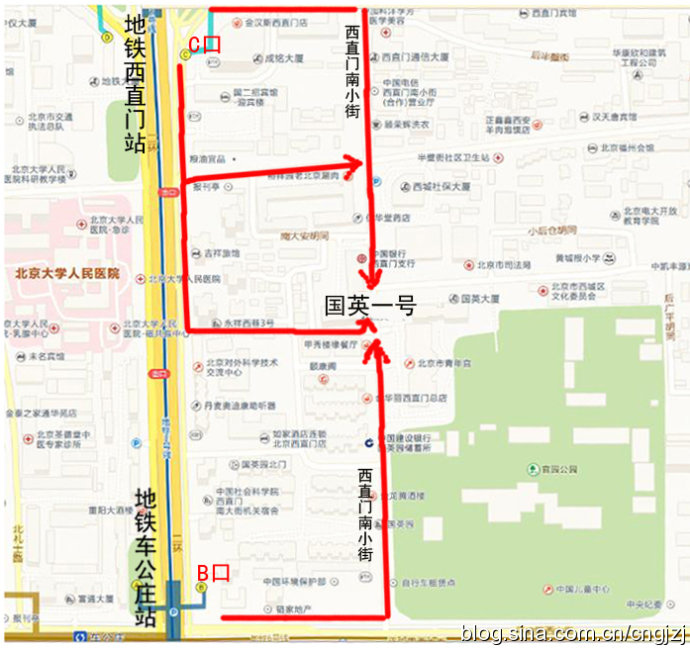中国民间中医医药研究开发协会国际针灸合作委员会
办公地点现在已经搬迁至西城区西直门南小街国英园一号楼824室,
同时为方便大家联系,固定电话已经变更
新号码010—58562339。特此通知。
地址:北京西城区西直门南小街国英园一号楼824室
邮编:100035
电话:010-58562339
传真:010-58562339
邮箱:cngjzj@163.com
网站(点击网址直接链接↓):http://www.cngjzj.com/
博客(点击网址直接链接↓):http://blog.sina.com.cn/cngjzj
交通路线图 (点击观看大图)

从首都机场乘坐机场专线,在东直门站下车换乘地铁2号线开往西直门方向,在西直门站 C 口出站:
1、沿西直门内大街向东直行100米,右拐到西直门南小街,向南步行到丁字路口即到国英园1号楼楼下。
2、向南直行50米,绕过 国二招宾馆 沿着中大安胡同向东到西直门南小街,向南步行到丁字路口即到国英园1号楼楼下。
从首都机场内乘坐机场直达西单的大巴,在西单站下车,乘坐出租车到西直门南小街国英园1号楼。
公交官园站:107路,运通106路
公交西直门南:387路,44路,800内环,816路,820内环,845路
地铁车公庄:地铁二号线
地铁西直门:地铁二号线
公交车公庄东:107路,118路,701路
公交车公庄北:209路,375路,392路
 您现在的位置是:
首页 >>
Chinese health 中医保健 >>
Family health medicine 家庭
您现在的位置是:
首页 >>
Chinese health 中医保健 >>
Family health medicine 家庭
2015年01月30日
 复制链接
复制链接
 打印
打印
 大 中 小
大 中 小
How to effectively deal with winter respiratory infections
China's traditional Chinese medicine to
Winter is the season of respiratory infectious diseases, due to the temperature falls, viruses, bacteria are more likely to survive, combined with the human nasal mucosa by cold air stimulation, lower's ability to fight the infection. Under the effect of two aspects, the easier to induce or aggravate respiratory disease.
Pediatric clinical antibacterial drug abuse is the worst-hit areas
Pediatric respiratory infection is the common pathogenic bacteria of streptococcus pneumoniae, haemophilus influenzae, staphylococcus aureus and chlamydia, mycoplasma, etc. The U.S. centers for disease control and prevention joint of the American academy of pediatrics updated guidelines had explicitly for upper respiratory tract infection of bacterial drug principle: first determine if the patient has the possibility of bacterial infection, followed by weighing the pros and cons of using antibiotic treatment, the proper use of antimicrobials. Traditional penicillin and cephalosporin class of antibiotics commonly used treatment curative effect is poor.
When antibiotics abuse and impedance of clinical background, the traditional Chinese medicine for the treatment of respiratory tract infection gives a new way of thinking. Choose some qingrejiedu Chinese traditional medicine, phlegm heat injection, for example, often can obtain good curative effect. The drug has the effect of heat, cough, phlegm, can inhibit streptococcus, beta hemolytic streptococcus pneumonia, flu virus pathogens, such as inhibition of prostaglandin E2 (PGE2), central heating medium cyclic adenosine monophosphate (cAMP), allergic reaction process to suppress the immune cells, so as to realize antibacterial, antiviral effect, shorten the course of the disease.
Alert to the elderly
Flu-related deaths of more than 95% of the time is happened to the elderly over the age of 60. A significant share of related deaths are caused by respiratory and cardiovascular disease.
Once the elderly respiratory tract infection caused by influenza, often cannot effectively control, break out repeatedly, easy to cause multiple organ failure. And application history of older people often have many kinds of antimicrobial agents, increased antimicrobial resistance. In recent years, the combined use of antimicrobial action of clinical Chinese medicine injection paid close attention to, and clinical data have shown that older lower respiratory infection symptoms rapidly after application of phlegm heat injection of effective control, and clinical effect is superior to the simple use of antimicrobial agents, has good safety.
Reveal phlegm heat injection
TCM holds that acute respiratory infection in lung fever for wind temperature, more is the lung fever heat by the nose and mouth attack lung department, such as body heat, cough and gasp the, thirst for the main performance of a kind of acute exogenous febrile. Some Chinese medicine preparations, especially known as the "green antibiotics," said the qingrejiedu kind of traditional Chinese medicine (TCM), become a combination therapy of severe infection, mild infection, replace the antibiotics of choice.
Phlegm heat injection is composed of radix scutellariae, bear bile powder, horns, five kinds of Chinese herbal medicine flos lonicerae and fructus forsythiae refined but become, have qingrejiedu, phlegm spasmolysis effects. Modern pharmacological studies have shown that scutellaria have anti-inflammatory and anti allergy effect, can alleviate the experimental animals of allergic airways shrinks, has broad antibacterial, antiviral and antipyretic effect; Bear bile powder have spasmolysis effect; Horns have strong antipyretic role; Honeysuckle, forsythia, restrain and kill for a variety of pathogenic microorganisms.
Phlegm heat injection can through the combination of drug molecular specificity to activate the body's pituitary - adrenal cortex function, promote the formation of angiotensin, to shrink other symptoms of patients with peripheral vascular reduction. Also inhibits blood capillary permeability to control the formation of the tissue edema. And can quickly improve sense on the signs and symptoms of patients, reduce the occurrence of complications. Compared with the similar resistance to drugs, phlegm heat injection did not see obvious allergic report, not only safe, also saves the loaded down with trivial details that the skin test.
In addition to the drug by raising their own immunity have the effect of kill virus, less side effects, antiviral effect quickly is also a big advantage, to improve the symptoms of sore throat, cough, fever and other aspects rapidly; Also has the overall adjustment, can shorten the course of the disease, promoting disease recovery, and immune regulation, especially suitable for upper respiratory tract infection patients.
Clinical use of phlegm heat injection to treat acute bronchitis, pneumonia, chronic obstructive pulmonary disease, etc., can not only relieve the symptoms of respiratory tract infection, accelerate the process of defervescence, quick effect, short course of treatment, side effects, small and easy to use, drug delivery approach exact, synergy and antibiotic use. Can be used as a drug of choice for antiviral, antibacterial, also suitable for emergency use. (ning-bo zhao)
The original link: http://www.cntcmvideo.com/zgzyyb/html/2015-01/29/content_95420.htm